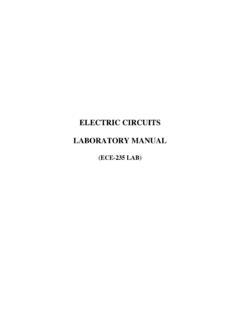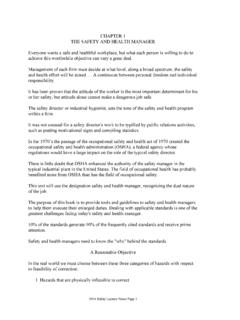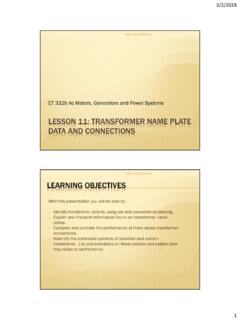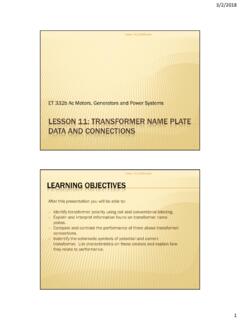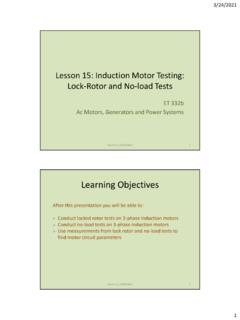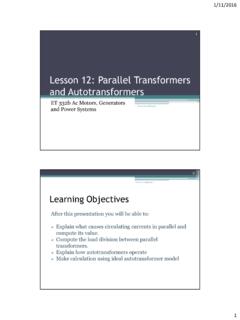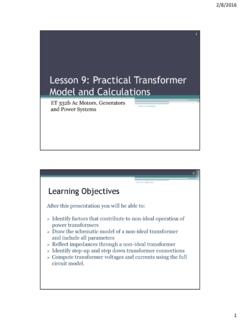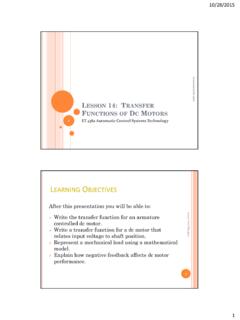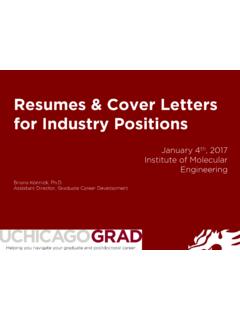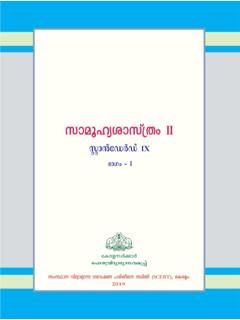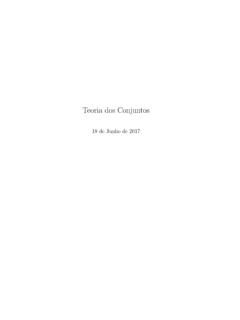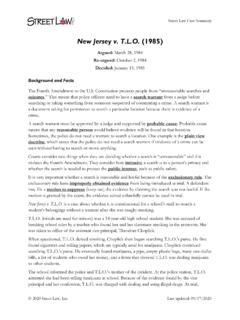Transcription of CHARACTERISTICS OF PULSE AND SQUARE WAVES
1 4/6/2017 1 CHARACTERISTICS OF PULSE AND SQUARE WAVES Lesson 17 EET 150 In this lesson you will: compare idea waveforms to actual waveforms define PULSE rise and fall times see PULSE and SQUARE wave signal not based at zero volts define the parameters PULSE width and duty cycle see PULSE tilt, undershoot, overshoot, and ringing Learning Objectives 4/6/2017 2 Ideal versus Actual PULSE Waveforms Idea waveforms are a theoretical concept Function generators produce non-ideal WAVES that approximate theoretical shapes The Comparison Ideal (Theoretical) Actual (Generated) Levels can change Instantaneously Levels change requires a finite time Waveforms have no harmonic distortion Harmonic distortion adds small amounts of other frequencies Waveforms have unlimited amplitude Amplitudes limited to capabilities of generator PULSE Waveform CHARACTERISTICS An Ideal PULSE t1t2 TimeAmplitudePulseWidthAmplitude Rising Edge Falling Edge Ideal PULSE width, tp = t2 t1 4/6/2017 3 PULSE Width An Actual PULSE TimeAmplitudeDefinition : PULSE width, tp, is the time difference between the 50% amplitudes of the rising and falling edges.
2 A A/2 tp t1 t2 PULSE CHARACTERISTICS Positive and Negative Pulses Positive pulses increase from baseline voltage TimeAmplitudeV baseline =0 V baseline >0 4/6/2017 4 PULSE CHARACTERISTICS Positive and Negative Pulses Negative pulses decrease from baseline voltage time +Amplitude-AmplitudeNegative PULSE with positive base voltage Negative PULSE with negative base voltage PULSE CHARACTERISTICS PULSE rise- time and fall- time TimeAmplitude90% 10% tr tf Rise- time , tr, = time required for rising edge of PULSE to go from 10% to 90% of amplitude Fall- time , tf, = time required for falling edge of PULSE to go from 90% to 10% of amplitude 4/6/2017 5 PULSE CHARACTERISTICS PULSE Tilt TimeAmplitudeV1 V2 V 221 VVV V is the average of max and min values %VVVTilt%10021 00.
3 0 20 .0 40 .0 60 .0 80 .10 .1 20 .1 40 .1 60 .1 8101234 PULSE W ith R ingingTimeAmplitu d e41 2et()0 .1 70tPulse CHARACTERISTICS Overshoot and Ringing Overshoot occurs on rising and falling edges when the waveform exceeds the desired value. Ringing occurs on rising and falling edges when the waveform alternates about the desired value. 4/6/2017 6 PULSE CHARACTERISTICS Overshoot and Ringing Watch for the overshoot and ring on this graph PULSE frequency is also known as PULSE repetition rate (PRR) PULSE Frequency PRR is period in which the PULSE pattern repeats TimeAmplitudeT T = Period (Seconds) PRR = PULSE repetition rate (Hz) or pulses/second TPRR1 4/6/2017 7 PULSE Duty Cycle Percent of the period that PULSE is at its high level TimeAmplitudeT tp T = period tp = PULSE width %period widthpulse Cycle Duty100 %Tt Cycle Dutyp100 PULSE Duty Cycle Example TimeAmplitudeT= S tp = S 30% Cycle Duty%S Cycle Duty 1004/6/2017 8 Variable Duty Cycle TimeAmplitude60% 70% 90% 30% T 0 tp T End Lesson 17 EET 150 Coming Next.
4 Function Generator Controls and Operation CHARACTERISTICS of PULSE and SQUARE WAVES
